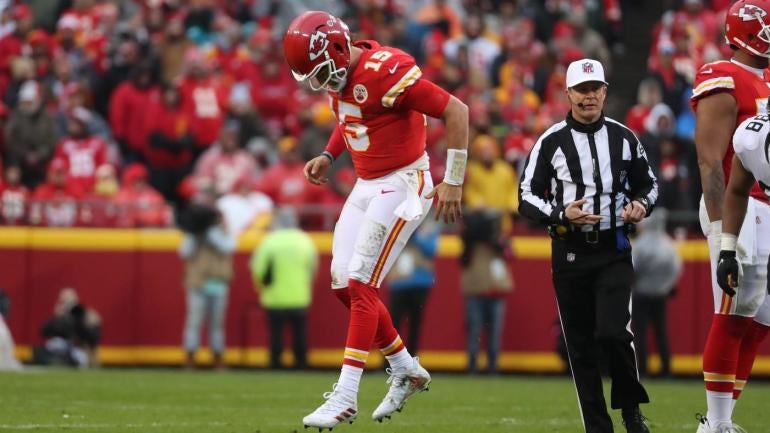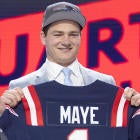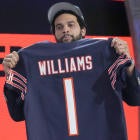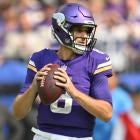
On Saturday, we witnessed Patrick Mahomes hobbling up and down the field at Arrowhead Stadium to lead the Kansas City Chiefs back to their fifth consecutive AFC Championship in a 27-20 win against the upstart Jacksonville Jaguars. We also saw the Philadelphia Eagles tie their biggest margin of victory in a playoff game in franchise history with their 38-7 curb-stomping of their NFC East rival, the New York Giants.
Sunday around the NFL was pretty wild as well. The Cincinnati Bengals marched into Buffalo and trounced the Bills, 27-10, to prevent a neutral site AFC Championship Game. The Cowboys had multiple chances, but they couldn't overcome an injury to running back Tony Pollard, as well as their poor execution, in their season-ending 19-12 loss at the San Francisco 49ers.
The second week of the NFL playoffs included the league's eight most elite teams, so there was obviously some high-level football being played. However, there was also plenty of confounding football as well across the weekend. Here are some of the head-scratching decisions that occurred this divisional round weekend.
Chiefs' handling of Patrick Mahomes' injury
Every Chiefs player, coach and fan experienced their worst nightmare in the Chiefs' 27-20 win in the opening game of the divisional round playoffs on Saturday afternoon: an injury to Mahomes. The 2022 first-team All-Pro passer got sandwiched by two Jacksonville Jaguars defenders as he threw a pass, causing his leg to bend at a painful angle. Mahomes initially grabbed both his right knee and ankle in agony after the play.
Even though Mahomes asked head coach Andy Reid to stay in the game, it was head-scratching to see him skip around like he was playing hop-scotch to execute basic, under-center handoffs to his running backs. He did not receive any brace before going back out for the next play, not missing any time. Mahomes then got his ankle taped and came back in the game, continuing to not miss any plays.
Eventually, the Chiefs inserted back up quarterback Chad Henne into the game. Henne, who led Kansas City to victory in the 2020 AFC divisional round against the Cleveland Browns after a Mahomes injury, led Kansas City on a 98-yard touchdown drive that he capped off with a one-yard touchdown pass to tight end Travis Kelce. That pass marked Henne's first touchdown in his playoff career.
The game was tied at 7-7 when the injury occurred. The Chiefs turned that drive into a field goal to make it 10-3 and extended their lead to 17-7 after Henne's first-career postseason TD pass. Yet, Mahomes went back on to the field to start the second half. Mahomes was still hopping around while running under-center handoffs near the goal line in the fourth quarter. The presumptive league MVP's mobility was clearly hampered by the injury, as none of his 18 passes were outside of the pocket following the injury.
Patrick Mahomes before/after injury
| Before | After | |
|---|---|---|
Comp/Att | 10/12 | 12/18 |
Attempts outside pocket | 6 | 0 |
Average time to throw | 3.12 | 2.57 |
Passer rating | 121.2 | 103.5 |
While it is the postseason, it was still strange seeing the Chiefs risk a long-term injury to the face of their franchise. Mahomes continuing to hobble around on his injured ankle during the divisional round game could put him in a worse spot for the AFC championship game as well next week, a game he says he'll play in after being diagnosed with a high-ankle sprain.
Andy Reid loses timeout over unnecessary challenge
Facing second-and-seven from their own 23 with 7:48 remaining in the third quarter, Chiefs running back Isiah Pacheco caught a swing pass toward the left sideline from Mahomes and gained six yards, getting marked just short of the line to gain for a first down. Reid decided that instead of facing third-and-inches, having two plays to get just under a yard, he would rather have the first down immediately.
With the call on the field being short of a first down, Reid needed indisputable video evidence to win the challenge, something that didn't happen, so Kansas City lost a timeout and a challenge early into the final 30 minutes of action. The Chiefs then opted to run a direct snap to tight end Noah Gray in order to pick up the first down that was stuffed by the Jaguars defensive line. Kansas City then punted since it was already backed up in its own end of the field. That sequence marked a few poor coaching decisions in terms of play-calling and timeout usage that didn't end up hurting Chiefs this week, but that type of sequence could come back to burn them against the Bengals, the team that ended their season a year ago in the AFC Championship.
Bills forget to cover Ja'Marr Chase
Burrow to Chase is AUTOMATIC in the #NFLPlayoffs.
— NFL (@NFL) January 22, 2023
📺: #CINvsBUF on CBS
📱: Stream on NFL+ https://t.co/RqOcaBu1Zc pic.twitter.com/8uSokUrjBO
Bengals wide receiver Ja'Marr Chase blows by defenders on a regular basis for wide-open touchdowns, as his six receiving scores of 50 or more yards are the most in the entire NFL since he entered the league in 2021. However, his 28-yard touchdown to begin the AFC divisional round matchup between the Bengals and the Bills was unusual because he was stunningly WIDE OPEN against a secondary that ranked inside the top 10 for the fewest passing touchdowns allowed in the regular season.
Spot the open Bengal ⚪️ pic.twitter.com/0U5vCr52Ex
— NFL (@NFL) January 22, 2023
It appeared there was a coverage bust in the middle of Buffalo's zone coverage, but nevertheless, it's still head-scratching to see such a high-profile top option THAT open in a divisional round playoff game. Seeing the play in dots form, courtesy of NextGen Stats, makes the defensive coverage look even more mind-numbingly off.
Burrow to Chase, touchdown dots! (Sadly, snow not featured)@NextGenStats pic.twitter.com/pZTQmlHxGY
— Seth Walder (@SethWalder) January 22, 2023
Controversial TD overturn
Matt Milano forces the ball loose to prevent the TD.
— NFL (@NFL) January 22, 2023
📺: #CINvsBUF on CBS
📱: Stream on NFL+ https://t.co/RqOcaBu1Zc pic.twitter.com/Y66X4uxf9z
Initially, Chase had caught his second touchdown of the first half Sunday, this time from 10 yards out on third-and-goal. However, replay review overturned the call on the field of a touchdown, and Cincinnati settled for a 28-yard field goal to take a 17-7 lead instead of a 21-7 lead. The NFL has re-written its catch rule several times in recent years, especially after backlash from the Cowboys and their fans when Dez Bryant's fourth-down catch with just more than four minutes left in the 2014 divisional round was overturned on a replay review.
While it has since softened its stance on surviving the ground, the NFL is apparently still looking for perfection when it comes to the football's movement while securing a catch. It's quite understandable to come away from looking at the replay of Chase's near-score and only see the call on the field, which was Chase hauling in another touchdown.
Kyle Shanahan's first-half timeout usage
Following Dak Prescott's second interception of the first-half, the 49ers took over at their own 28-yard line with 1:24 left in the first half of a tie game. Head coach and offensive play-caller Kyle Shanahan then opted for a curious sequence of play-calling: a run with wide receiver Deebo Samuel and a run with running back Christian McCaffrey. Those two plays gained only nine yards, making it seem like Shanahan was content to go into the locker room tied at six.
However, he then called the 49ers' second timeout after those two plays, leaving his team a third-and-one with 30 seconds to go. Following the timeout, quarterback Brock Purdy threw a 10-yard pass to Samuel that reached their own 47, and Shanahan called another timeout. The initial two plays, followed by the conversion, would lead most to think that was going to be it for the first half. However, the 49ers then had zero timeouts and a first down near midfield. It ended up all working out for Shanahan and San Francisco, as Purdy sandwiched a 21-yard completion to receiver Jauan Jennings in-between three incompletions, the last of which sailed out of bounds with only a second left on the first-half clock.
Although the 49ers were able to take a 9-6 lead into the break, it appeared as though Shanahan couldn't decide what he wanted to do to end the half, leading to some confusing timeout usage and mixed messaging.
Elijah Mitchell gives Cowboys hope
Elijah Mitchell up the sideline!
— NFL (@NFL) January 23, 2023
📺: #DALvsSF on FOX
📱: Stream on NFL+ https://t.co/WBXF8YHjXz pic.twitter.com/AdG1E7kWIl
The Cowboys were on the ropes after punting the football back to the 49ers trailing, 19-12, with just over two minutes to go, but they still had four opportunities for the clock to be stopped between the two-minute warning and all three timeouts. Two or three first downs, if handled correctly, would have sealed the game and kept the Cowboys from getting one last chance.
Fast-forward to 1:53 left in the game, and the 49ers facing a second-and-nine. The Cowboys had already used a timeout, so staying inbounds for another first down would have all but sealed the game. Mitchell checked the first box, blowing by the Dallas defense for a new set of downs. But here was the problem: he went out of bounds. Almost every time a player gets in that situation, they go out of their way to do a baseball slide in the field of play to keep the clock moving, but Mitchell's adrenaline likely got the best of him as he jogged out of bounds. That decision allowed the Cowboys to get the ball back, and he's fortunate his defense stood tall. Otherwise, he would be dealing with some uncomfortable thoughts entering the offseason.
49ers' conservative final offensive drive
Kyle Shanahan gets praise for his offensive innovation, and rightfully so, but his play-calling on the final drive became uber-conservative, and the risk-averse play-calling allowed the Cowboys to get the ball back one last time. After Mitchell picked up a first down, the next three plays gained a combined zero yards: a Mitchell run up the middle for one yard, another Mitchell run up the middle that went for no gain, and a horizontal pass from Purdy to McCaffrey that lost a yard. For all the motion and unique usage of his fullbacks, tight ends and receivers, Shanahan going run, run, pass when one more first down would've ended the game was bewildering.
Cowboys' cringeworthy end to season
This is how the Cowboys ended their season with their final 2 plays
— Someone's An Idiot (@SomeonesAnIdiot) January 23, 2023
First: Dalton Schultz doesn’t even bother putting his other foot down in bounds
Second: Mike McCarthy goes insane and the receiver doesn’t even bother trying to pitch it
Season over pic.twitter.com/3PF2qJXzBT
In college football, a player can complete a catch while getting just one foot down inbounds. However, two feet are required to do so in the pros. It appeared as though Schultz had a brain-fart regarding those rules in a humongous spot. It appeared as though he initially made a critical 15-yard gain to get Dallas into Hail Mary range with six seconds left in the game. Unfortunately for the Silver and Blue, the Cowboys tight end clearly didn't get his second foot down upon review, pushing them back to their own 24-yard line.
Dallas appeared to choose to go with a hook-and-ladder play to try and score a miracle touchdown, but multiple components of the play resulted in the failed execution. The first one is using return man and wide receiver KaVontae Turpin as the player to pitch the ball to a sprinting teammate. Turpin is the fastest player on the Cowboys, meaning he should have been the one receiving the pitch after the initial catch, not the one setting up the play. The other flaw was Turpin's execution in the initiator spot since he completely failed to get the ball out of his hands quick enough for even one other Cowboy to touch the football. A failure in scheme and execution doomed the Cowboys' final play of their 2022 season.
























